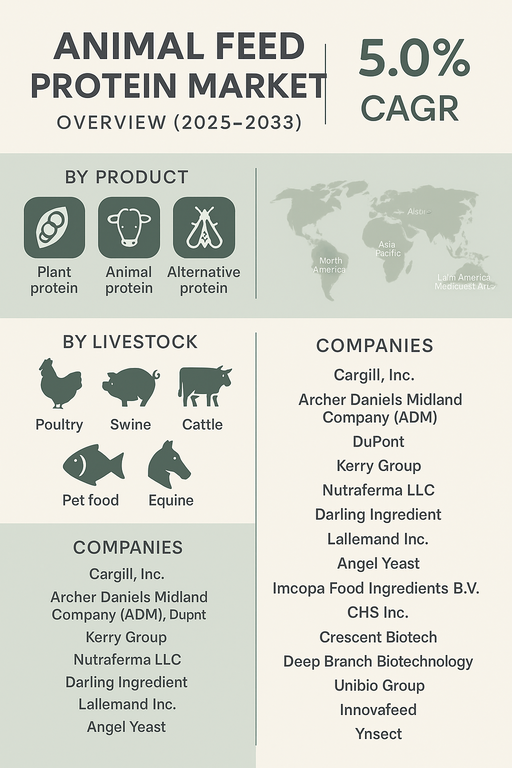The global animal feed protein market is projected to grow at a CAGR of 5.0% from 2025 to 2033, driven by rising demand for high-quality livestock products, increased emphasis on animal nutrition, and growing adoption of sustainable and alternative protein sources. Feed proteins are essential in enhancing animal growth, immunity, and overall productivity, directly supporting the rising global consumption of meat, dairy, aquaculture products, and pet food.

Growing Demand for Sustainable and Alternative Protein Sources
Animal feed producers are increasingly focusing on diversified protein sources to meet sustainability and food security goals. Plant-based proteins, such as soybean meal and rapeseed, remain the most widely used due to cost-effectiveness and availability. However, the market is witnessing rapid growth in alternative protein sources such as insect protein, microbial protein, and single-cell protein, supported by circular economy initiatives and reduced environmental impact. In aquaculture and pet food, premium protein-rich formulations are gaining traction to meet consumer demand for healthier and sustainable animal-derived products.
Challenges: Volatility in Raw Material Prices and Regulatory Constraints
The market faces challenges related to raw material price fluctuations, especially for soybean and fishmeal, which impact overall production costs. Regulatory restrictions on the use of certain animal-based proteins in feed formulations also create barriers in specific regions. In addition, consumer concerns about sustainability, traceability, and animal welfare are pressuring feed manufacturers to adopt innovative and transparent sourcing practices. Despite these challenges, advancements in fermentation technology, insect farming, and microbial protein production are creating long-term growth opportunities.
Market Segmentation by Product
By product, the market is segmented into plant protein, animal protein, and alternative protein. Plant protein dominates the market due to widespread availability and cost efficiency. Animal protein, including fishmeal and meat by-products, continues to play a key role in high-value livestock and aquaculture feed. Alternative proteins are the fastest-growing category, with insect-based and microbial proteins gaining acceptance for their sustainability and nutritional profiles.
Market Segmentation by Livestock
By livestock, the market is segmented into poultry, swine, cattle, aquaculture, pet food, and equine. Poultry represents the largest segment due to global demand for poultry meat and eggs. Swine and cattle feed remain significant, especially in North America, Europe, and Asia. Aquaculture is the fastest-growing livestock segment, supported by rising global fish consumption and the need for protein-dense feed. Pet food is also expanding rapidly, with premium formulations driving protein demand. Equine feed, while niche, contributes to the overall diversification of protein applications.
Regional Insights
In 2024, Asia Pacific led the animal feed protein market, driven by large-scale poultry, swine, and aquaculture industries in China, India, and Southeast Asia. North America followed, with strong demand for cattle and pet food protein. Europe is a leader in alternative and sustainable protein adoption, with countries like France, the Netherlands, and Germany investing heavily in insect protein and fermentation-based feed solutions. Latin America is a major supplier of plant proteins, particularly soybean meal from Brazil and Argentina. Middle East & Africa (MEA) represents an emerging market, with rising investments in poultry and aquaculture to meet regional protein demand.
Competitive Landscape
The 2024 market was characterized by a mix of global agribusiness giants and innovative alternative protein startups. Cargill Inc. and Archer Daniels Midland Company (ADM) dominate with strong portfolios in plant and animal feed proteins. DuPont and Kerry Group focus on functional and specialty proteins for advanced formulations. Darling Ingredient, Lallemand Inc., and Angel Yeast provide animal-based proteins, yeasts, and microbial solutions. CHS Inc. and Imcopa Food Ingredients B.V. contribute significantly in plant-based protein supply chains. Emerging innovators such as Deep Branch Biotechnology, Unibio Group, Innovafeed, and Ynsect are leading in alternative proteins, particularly insect and microbial-based sources. Competitive strategies center on sustainability, cost efficiency, technological innovation, and geographic expansion.
Historical & Forecast Period
This study report represents analysis of each segment from 2023 to 2033 considering 2024 as the base year. Compounded Annual Growth Rate (CAGR) for each of the respective segments estimated for the forecast period of 2025 to 2033.
The current report comprises of quantitative market estimations for each micro market for every geographical region and qualitative market analysis such as micro and macro environment analysis, market trends, competitive intelligence, segment analysis, porters five force model, top winning strategies, top investment markets, emerging trends and technological analysis, case studies, strategic conclusions and recommendations and other key market insights.
Research Methodology
The complete research study was conducted in three phases, namely: secondary research, primary research, and expert panel review. key data point that enables the estimation of Animal Feed Protein market are as follows:
Market forecast was performed through proprietary software that analyzes various qualitative and quantitative factors. Growth rate and CAGR were estimated through intensive secondary and primary research. Data triangulation across various data points provides accuracy across various analyzed market segments in the report. Application of both top down and bottom-up approach for validation of market estimation assures logical, methodical and mathematical consistency of the quantitative data.
| ATTRIBUTE | DETAILS |
|---|---|
| Research Period | 2023-2033 |
| Base Year | 2024 |
| Forecast Period | 2025-2033 |
| Historical Year | 2023 |
| Unit | USD Million |
| Segmentation | |
Product
| |
Livestock
| |
|
Region Segment (2023-2033; US$ Million)
|
Key questions answered in this report